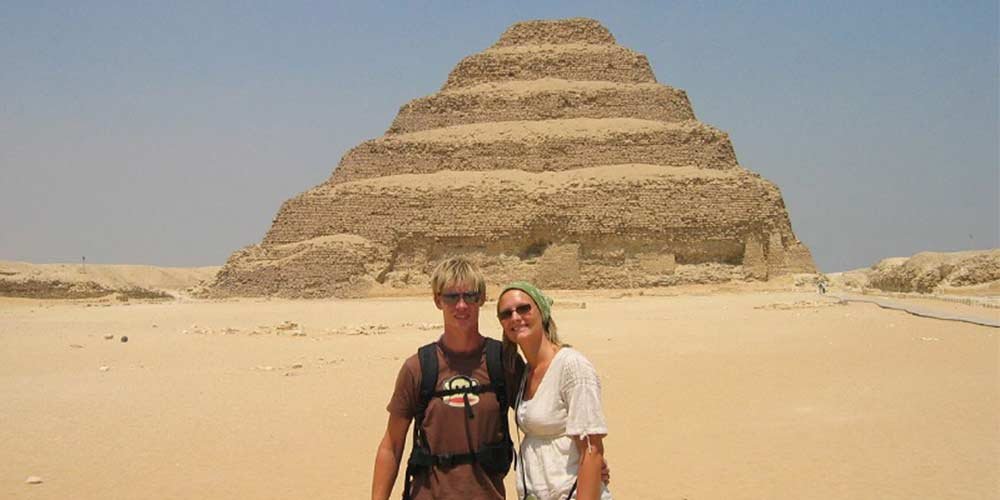Explore Amazing Saqqara : 1 of most famous pharaonic places
Saqqara Unveiled: Egypt’s Underrated Historical Gem
The name ‘Egypt’ immediately conjures up images of majestic pyramids, golden pharaohs, and mysterious tombs. While Giza’s pyramids often steal the limelight, a short distance away lies Saqqara, an ancient burial ground serving as a treasure trove of history, mystery, and architectural innovation. As one of the richest archaeological sites in Egypt, Saqqara offers an unparalleled journey through millennia of Egyptian history.
Also known as the “Step Pyramid,” Djoser’s Pyramid stands in the Saqqara Necropolis.
The pyramid consists of six mastabas and inside the pyramid there are galleries and wells dug directly into the rock, in which a deposit of mummies of the royal family was found.
The white and turquoise ceramics that were found inside the pyramid and the very heavy pink granite slabs that covered the burial chamber are very famous.
Also in Saqqara is the tomb of Mehu, recently opened to the public for the first time since its discovery in 1940. This dignitary of the sixth dynasty was buried with the highest honors in a place which, thanks to its secluded position, managed to survive the raids of looters and to keep its hieroglyphs in good condition.
1. Historical Background:
Saqqara, located south of modern-day Cairo, was the necropolis for the ancient Egyptian capital of Memphis. Spanning over six square miles, it served as the final resting place for pharaohs, high officials, and countless others for thousands of years.
When was the Saqqara pyramid built?
Built by Imhotep, one of history’s first recognized architects, during the reign of Pharaoh Djoser around 2630 BCE, the Step Pyramid was the focal point of the Third Dynasty ruler’s funerary complex, which also included an impressive hypostyle entry hall.
The step pyramid, which stands over 200 feet (60 meters) tall and has a base of 358 feet by 397 feet (109 meters by 121 meters), was Egypt’s first successful pyramid-building attempt and is one of the world’s oldest monumental cut stone structures.
Djoser’s Pyramid is significant not only as an engineering marvel, but also for paving the way for the construction of Egypt’s “true pyramids” in Giza and elsewhere.
2. Step Pyramid of Djoser:
Central to Saqqara is the Step Pyramid of Djoser, designed by the legendary architect Imhotep. Regarded as the world’s earliest colossal stone building, this six-tiered structure marks a significant evolutionary step between earlier mastabas (flat-roofed burial structures) and the smooth-sided pyramids of Giza. It’s not just a testament to Djoser’s ambition but also to the architectural and engineering prowess of ancient Egypt.
3. Mastaba Tombs:
The grounds of Saqqara are dotted with numerous mastabas. These rectangular structures, predating the pyramids, contain intricate carvings, statues, and inscriptions, providing invaluable insights into the daily lives, beliefs, and customs of ancient Egyptians.
4. The Pyramid Texts:
Inside the Pyramid of Teti, visitors can find the earliest known religious texts carved into the walls, aptly named the Pyramid Texts. These inscriptions are critical in understanding ancient Egyptian religious beliefs, cosmology, and rituals associated with death and the afterlife.
5. Recent Discoveries:
Saqqara is an archaeological goldmine, with new discoveries still emerging. Recent excavations have unveiled scores of well-preserved wooden coffins, mummies, and artifacts, some over 2,500 years old. These discoveries reiterate that Saqqara still has many secrets buried beneath its sands.
6. Animal Cults and the Serapeum:
A unique aspect of Saqqara is its Serapeum, a subterranean system of tunnels and tombs dedicated to the Apis bulls, revered as manifestations of the god Ptah. The size and scope of the Serapeum, with its massive sarcophagi, speak volumes about the religious and cultural significance of animal cults in ancient Egypt.
7. Visiting Saqqara:
A trip to Saqqara is like walking through a living museum. The site, though vast, is well-organized, with pathways leading to major attractions. Hiring a guide is recommended to grasp the historical context and intricate details of the monuments. As with all archaeological sites, respecting the grounds and structures is paramount.

Conclusion:
Saqqara stands as a testament to the ingenuity, beliefs, and rich tapestry of ancient Egyptian civilization. More than just a burial ground, it’s a place where art, architecture, and spirituality converge, capturing the essence of a civilization that flourished along the Nile millennia ago. A visit to Saqqara offers a deeper understanding of Egypt’s legacy, allowing one to touch the pulse of history itself.


Comment (0)